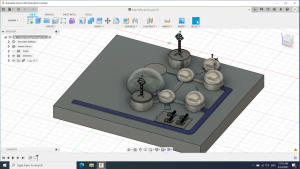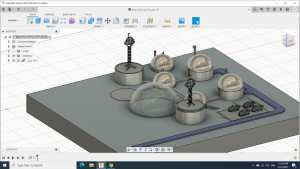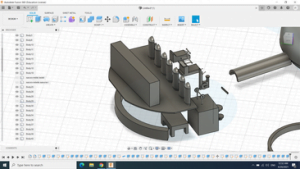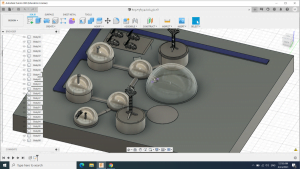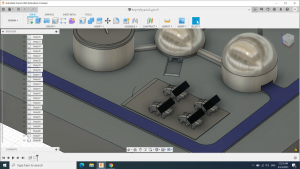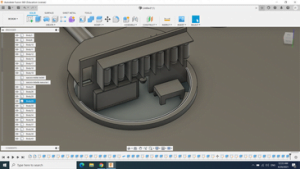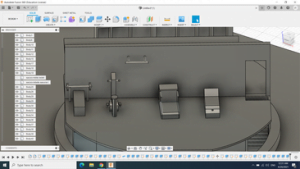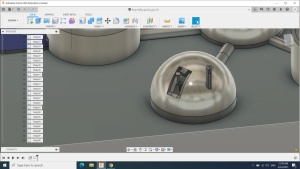Moon Camp Pioneers Gallery 2020-2021
In Moon Camp Pioneers each team’s mission is to 3D design a complete Moon Camp using Fusion 360. They also have to explain how they will use local resources, protect astronauts from the dangerous of space and describe the living and working facilities.
Team: Project Sirius
FABLAB ILIAUNI Tbilisi Georgia 14 or younger, 15, 16, 17
External viewer for 3d project
|
Project description
For us, colonization on the moon is a dream challenge. Our main goal: Development of lunar surface infrastructure (power systems, energy storage systems, in-space manufacturing assets, space mining assets) to enable future lunar surface scientific and commercial missions. When we gain some resources around a residential base then deploy our base satellites and expedition robots alternately at the South Pole in the Aitken Basin and Crevius Crater as the base is designed to gain local resources such as water (ice), metals and other resources. We build colonization on flexible lightweight landing platforms And in this regard we will connect the basic regolith to the surface structures.To create long-term human habitat, we decided to replace hydroponics by breaking down asteroid regoliths by fungi, which gives astronauts more advantage to bring the product to the moon. The project is designed to make colonization of the moon no longer a dream. It will be a reality that will allow us to show the moon through other eyes to humans and Not only astronauts. |
|||
|
Where do you want to build your Moon Camp?
In the past few years, it has become increasingly clear that the best place to put a crewed base is the lunar south pole. Scientists used LOLA (Lunar Orbiter Laser Altimeter), which was a device used by NASA to provide an accurate topographic model of the Moon. With this data locations near the south pole at Connecting Ridge, which connects Shackleton Crater to the de Gerlache crater,were found that yielded sunlight for 92.27–95.65% of the time based on altitude ranging from 2 m above ground to 10 m above ground. By locating a lunar resource processing facility near the south pole, solar-generated electrical power will allow for nearly constant operation.Sun exposure will help store unprotected resources. For example – ice, which means that it provides the colony with at least drinking water and oxygen after the moon.That’s why we want our base to be close to Shackleton Crater. How do you plan to build your Moon Camp? Describe the techniques and materials you would use.
We decided that Rather than bringing all the material, equipment, and power supplies needed to modify regolith for dust control and other foundation support for foldable landing pads, fixed landing pads or roads, “Regolith Adaptive Modification system (RAMs)” This concept was developed by Sarbajit Banerjee from a previous NASA proposal from NIAC. We use new microcapsule delivery systems that deliver precursors (nanothermite mixtures and organosilanes) which activate upon deployment to spot-weld anchor points binding the surface structures to the underlying regolith through in situ formation of advanced high-strength steel pegs. This same system delivers additional subsurface regolith stabilization precursors that are impelled deeper within the soil and activated by the initial exothermic reaction resulting in an underlying continuous layer of thermite-fused and geopolymerized regolith constituting a bulwark that provides additional load-bearing capacity. Dust mitigation and bearing capacity are accomplished, therefore, by both reaction/solidification chemistry and a physical mesh barrier. We will also have a Rover Hybrid for expedition work running on hydrogen and solar energy for 8 hours, designed for 4 astronauts. The environment on the Moon is very dangerous for the astronauts. Explain how your Moon Camp will protect them.
Astronauts are safe because, The novel technologies in the RAMs concept are: 1) a built-in microcapsule-based welding and regolith solidification system consisting of safer nanothermite mixtures and soil stabilizers designed to activate sequentially to form pig iron-based anchors as well as advanced high-strength and ductile steel anchors if needed. These anchors will extend along the rim of the platform and penetrate into the regolith matrix; 2) the use of energy stored within the chemical bonds of regolith components as the primary source to power in situ spot welding and creation of embedded alloy frameworks. This system will anchor assets like flexible pads to a planetary surface by generating in situ the equivalent of seismic grade alloys if needed. These alloys enable the platform to withstand the thermal and mechanical stresses incumbent during repeated propulsive landings. And if they are in danger during an expedition outside their residence, they will immediately contact the search and rescue team at the bazaar, for which the communication facilities and the on-board truck will provide radio communication within 48 hours. To maintain the health of the astronauts, we will have a special food ration and exercise space. Explain how your Moon Camp will provide the astronauts with:
|
|||
|
Water
|
Food
|
Electricity
|
Air
|
|
first of all For sampling we will use an autonomous robotic deep drilling demonstrator (ARD3).This concept was created by Quinn Morley. Proposed under this project an autonomous drilling system that would utilize a Perseverance-type rover as a drill rig. The rover would be outfitted with minimal but appropriate science instruments, and a drilling strategy that has a high level of redundancy. The drilling strategy does not rely on cables; instead, self-contained robots drive up and down the borehole autonomously. |
Hydroponics Instead, we propose to create soil from carbon-rich asteroid material, using fungi to physically break down the material and chemically degrade toxic substances. We will use fungi to help turn asteroid material into soil. The basic idea is to inoculate carbonaceous asteroid material with fungi to initiate soil formation. Fungi are excellent at breaking down complex organic molecules, including those toxic to other life forms.Indeed, evidence indicates that fungi played a key role in early soil formation on Earth.(We can do the same with us on the moon). |
Light Bender is a novel concept for the generation and distribution of power on the lunar surface within the context of the Artemis mission and the “Long-Term Human Lunar Surface Presence” that will follow. The innovative concept is based on a heliostat that utilizes Cassegrain telescope optics as the primary means to capture, concentrate and focus the sun’s light. A second key innovation is the use of a Fresnel lens to collimate this light for distribution to multiple end users at distances of a kilometer or more away without substantial losses. The redirected and concentrated solar energy is then converted to electricity at the end user’s location using small (2m-4m diameter) photovoltaic arrays that can be mounted on habitats, cryo-coolers, or mobile assets such as rovers or ISRU elements. |
First we take the amount of oxygen from the earth.Later we can extract oxygen from the moon surface itself in a process called molten salt electrolysis. This will turn moon soil into oxygen and other metals. also The plants will provide a small, but usable amount of oxygen through their photosynthesis, as well. |
|
Explain what would be the main purpose of your Moon Camp (for example: commercial, scientific, and/or tourist purposes).
We propose developing FLOAT – Flexible Levitation on a Track – to meet these transportation needs.Transportation will be FLOAT – Flexible Levitation on a Track.This project was developed by Ethan Schaller At NASA’s Jet Engine Lab.FLOAT robots have no moving parts and levitate over the track to minimize lunar dust abrasion / wear, unlike lunar robots with wheels, legs, or tracks. FLOAT tracks unroll directly onto the lunar regolith to avoid major on-site construction – unlike conventional roads, railways, or cableways.The walls also contain stable levels of oxygen and moisture so that people can live freely. FLOAT – Flexible Levitation Through the route we will transport the resources extracted in the crater and redistribute them in the reservoirs of our warehouses. |
|||
|
Describe a day on the Moon for your Moon Camp astronaut crew.
On Earth, the daily life-support requirements for one person are: We will have two groups of astronauts at the base. They will have a special shift schedule according to which they will be redeployed to the base. Once the astronauts wake up they will tidy up and eat breakfast . Astronauts Will be use NASA unwashed shampoo with a little water to maintain daily hygiene. After taking care of themselves, they go to the greenhouse to conduct research and get the product they want (part of this product they put in special containers to send to the earth for research, and part to take to the dining room).In space however, the water and food requirements are lower. This is why astronauts Will receive 0.84 kilograms of oxygen, 1.6 liters of drinking water and 1.77 kilograms of dry food daily. After wrapping up their morning routine, an astronaut begins their work assignments for the day, which can entail a number of different tasks. Much like homeowners do routine maintenance and other work around the house to protect the good health of their home, crew members are tasked with regularly checking support systems and cleaning filters, updating computer equipment and even taking out the trash. Astronauts spend their days working on science experiments. Experiments include extracting raw materials accumulated in the meteorite regolith, extracting water and oxygen from the moon’s crust.After that, they gather in the deliberation room and discuss this or that raw material, summarize today and make plans for the next day. After a tiring job, they still get the products they want from the greenhouse and have dinner. Also astronauts dedicate hours each day to fitness. On average, astronauts exercise about two hours per day in an effort to prevent bone and muscle loss while living in microgravity. After exercise they have the opportunity to unwind and at the end of the day they have the opportunity to contact family members. During the night, they will check and, if necessary, turn off the energy resources in one part of the base. Then a new day will begin for the second crew of the base. |
|||


